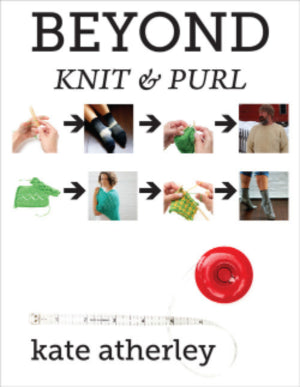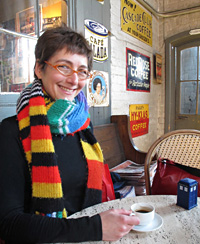Hey, did you know? I've just launched another new online class: this one specifically about casting on and binding off! It's ideal for newer knitters who are looking to build their skills.
(I don't like the knit cast on at all - it has very little to recommend it. The edge it makes is a frustrating combination of both too tight, and too loose. It lacks stretch, but yet it still flares out, and I don't like the look of the open loops at the edge.)
I do like the Cable Cast on, for many purposes. The only place it doesn't work well, I find, is when you want stretch - like for a top-down sock.
For that, I prescribe the Long Tail method. Nope, who I am kidding? I insist on the Long Tail Method for top-down socks.
If you don't know it, and haven't watched my class, the inimitable Lucy Neatby's video is very good.
There are two main questions that knitters have about this cast on....
1. How much tail do you need? There are accurate ways of estimating - Lucy mentions one - and then there's mine... For sock yarn, I leave half an inch (one cm) per stitch. For anything else, about an inch. I have never run short.
Yes, there's always too much - but that's not actually a bad thing. I am totally shameless about using my cast on tails to seam up, so having extra yarn is a good idea. And anyway, I'd rather not having to stress about being too close. (And really, if that extra yard is the difference between running out of yarn and not, you've got other problems... ) You use the two strands up at different rates - using up more of the one over your finger - and if you use a very accurate method and then mix up the two strands, you risk running out. (Ask me how I know... )
2. How to keep it loose. Knitters often tell me that they work this cast on too tightly. There are actually two different issues... are the stitches too tight, or is the edge too tight?
These are quite different problems, and the answers are quite different.
If the stitches are too tight, you'll find you might have difficulty knitting into them on your first row/round. If the edge is too tight, then your sock might not go on.
Knitters are often told that they should cast on over two needles held together, or even over a larger needle.
AHA! I often proclaim! No! This is a total red herring! I do my standard demo to prove this doesn't help.
If I cast on with two different color yarns, one for the finger, one for the thumb, you can see why....
the stretchiness of the edge is controlled by the yarn that lies in the foundation edge, along the needle, below the stitches. In this photo, that's the yellow yarn.
To make the edge stretchier, what you need to do is space the stitches out as you make them - leave some breathing room between the stitches. That is, you're making sure that there's lots of yarn in the foundation edge - lots of yellow. I like to leave at least a stitch's worth of space between the stitches, as you can see in the image above. (A knitter I spoke to last week said that her rule of thumb is to leave a needle's width between the stitches. I like that even more!)
Casting on over a larger needle doesn't change the amount of the foundation yarn (the yellow in this picture). All you're doing is making the stitches (the green loops) larger than they should be. If you knit these stitches normally, you're affecting the look of the first row, but not the stretchiness.
 |
| casting on over two needles held together... |
 |
| with second needle removed.. the sts are larger, but the edge isn't any looser |
HOWEVER. However! A conversation with Donna Druchunas that helped me realize that this two-needles trick still has value. Donna often casts on over two needles, even going so far as to specify it in her patterns. When editing a pattern of hers, I asked why, and was prepared to be all smug with my "superior knowledge". Her simple reply turned my world upside down... "Yes, I know the stitches are too big. I want them to be bigger."
So yes, IF you find it difficult to knit into the stitches in your first row/round, then yes, cast on over two needles held together, remove the second needle, and then working your first row/round. Donna also uses this as a substitute for a provisional cast-on... making the stitches too big provides enough room to knit into them from the other direction.
But if you can't get your sock on, then you need to space your stitches out more.
And then there's another point of debate... to start with a slip knot or not?
I always start with a slip knot, as I like how it looks -- that slip not looks like a stitch, and behaves more like a stitch. And when working in the round, I find it helps line up the join a little better. But it's not mandatory. When I'm teaching, I always start with a slip knot, as it tends to stay in place better - but once you've got the hang of the process, it's entirely personal choice.








7 comments:
Great article! Long tailed cast on is my favourite too. I have never figured out how to measure just enough, just always guessed (and am mostly right, but sometimes wrong) so it's good to have a method. Thanks. I start with a slipknot too. :)
:-D
And I never use a slip knot!
Love all this info! I'm sending this blog post straight to my evernote!!!
And you taught me everything I know. Long tail is my favourite and I do a slip knot.
And they say you can't teach new tricks to old timers! I have knitted socks for so many decades theat it is almost a shame to confess and the long-tail cast on has always felt too tight to me but I never caught on to the fact that the foundation of the cast on stitches was the culprit. Now, this sheds a new light on stretch. I am starting a new pair of top down socks today and I am giving the old long tail cast on another try.
Never too late to learn.
Great post! I'm a beginner knitter, and I love how quick and easy long tail casting on is. However, I find that after I cast on and begin the first row, I always have what I call a "yarn bridge" in between the two needles: basically a stretch of yarn that looks like a very loose stitch got caught in between the needles. Any idea on why this happens/ how to prevent it from happening? Thanks!
Olivia:
I've answered your comment in this blog post: http://wisehilda.blogspot.ca/2015/03/reader-mail-questions-about-blocking.html
Post a Comment